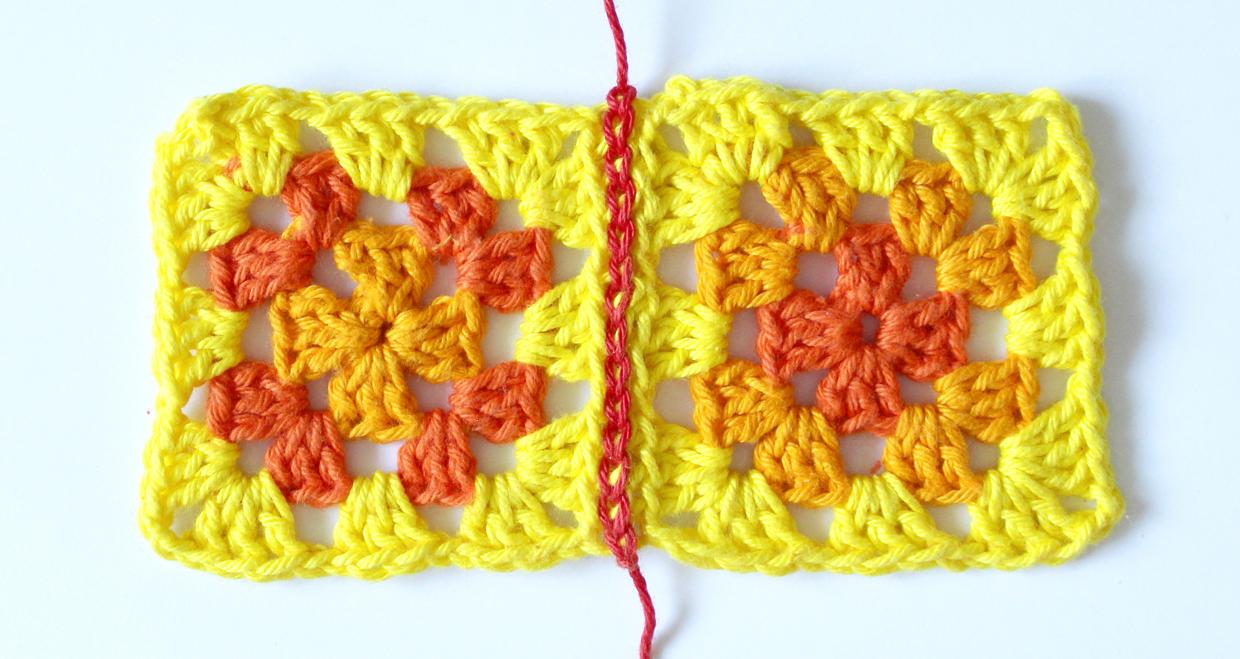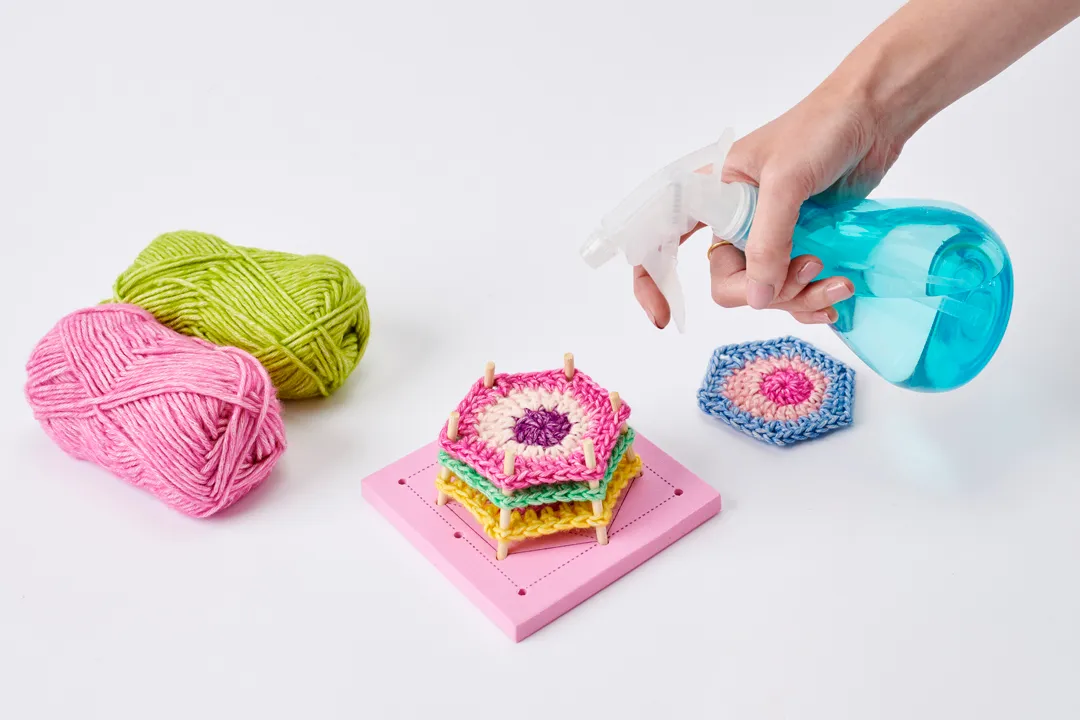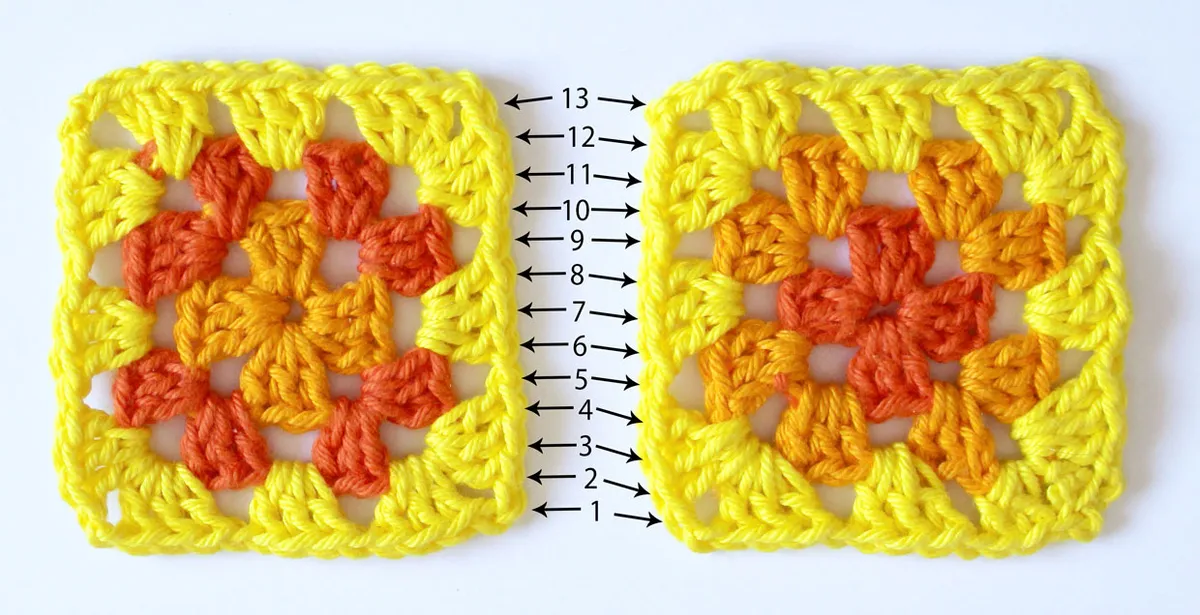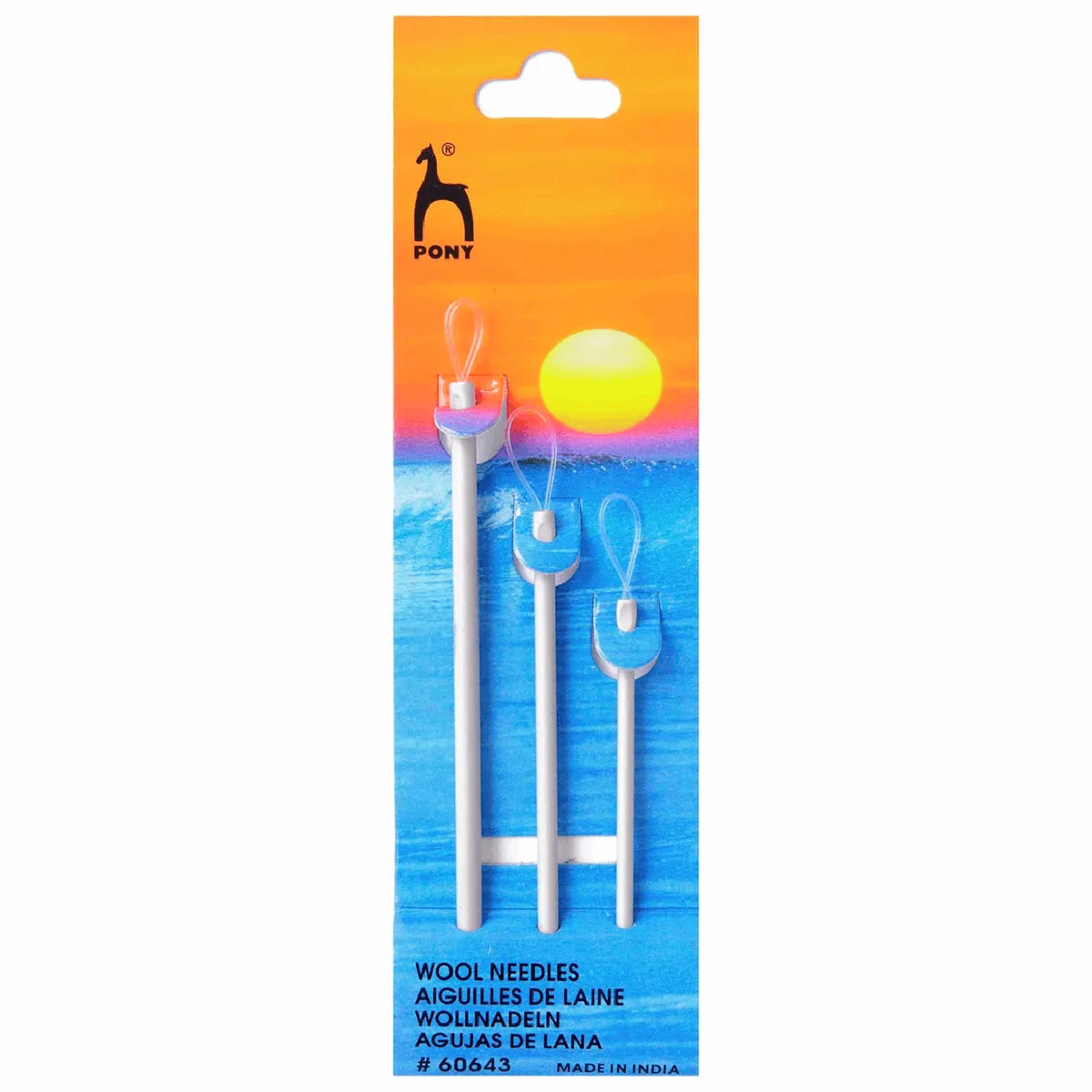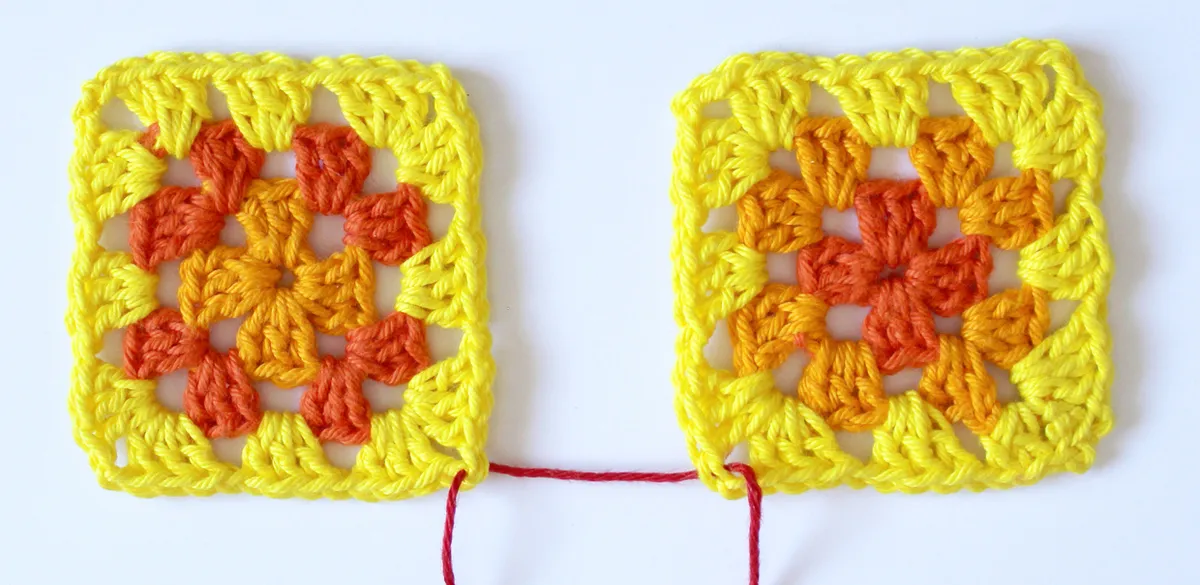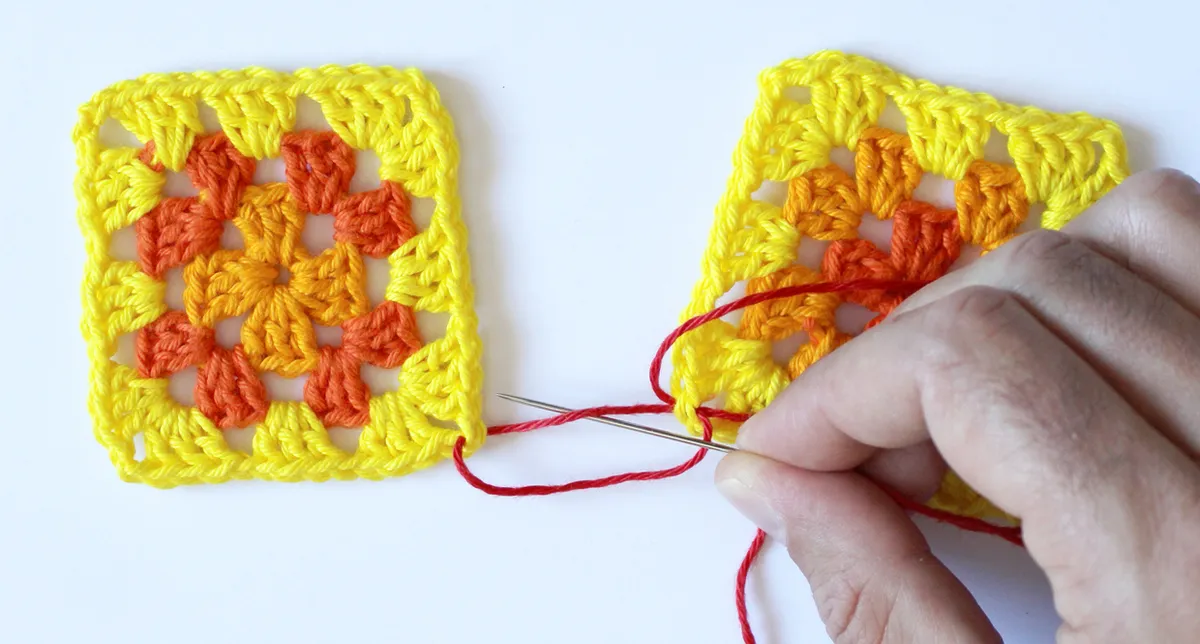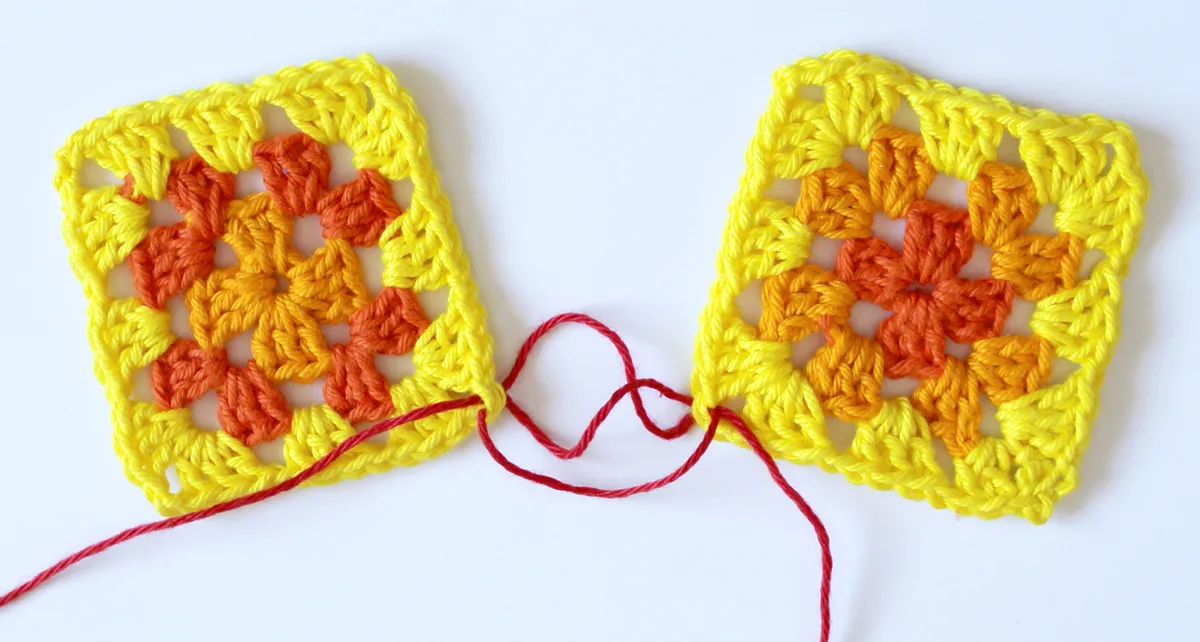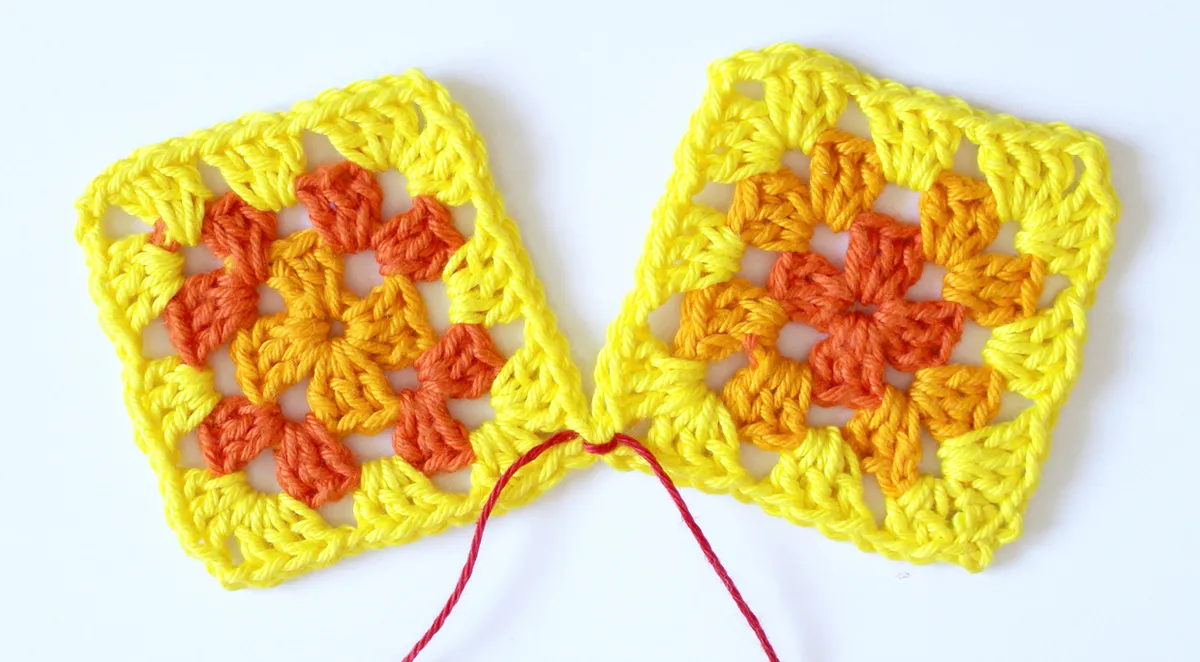Whip Stitch Crochet Join
Step 1
If you’re not too bothered about neatness and just want your shapes joined together asap, then the whip stitch crochet join is the simplest and quickest way of how to join your crochet pieces together. It’s easiest if you use a tapestry needle for this crochet joining technique, but you can do it with a crochet hook too.
Please note – for the neatest results with whip stitch, you would normally do this on the wrong side of your crochet, however to make it easier for you to see where we are inserting our needle we have done this tutorial with joins on the right side.
To make your crochet whip stitch less visible use the same colour yarn as on your crochet shapes, but we’ve used a contrasting yarn to make this tutorial easier to see.
Attach your yarn to both shapes using the method above.
Working into the next stitch up from your join, thread your needle (front to back) under both loops of the stitch on the right piece of crochet, and then thread your needle (back to front) on the parallel/corresponding stitch on the left piece of crochet
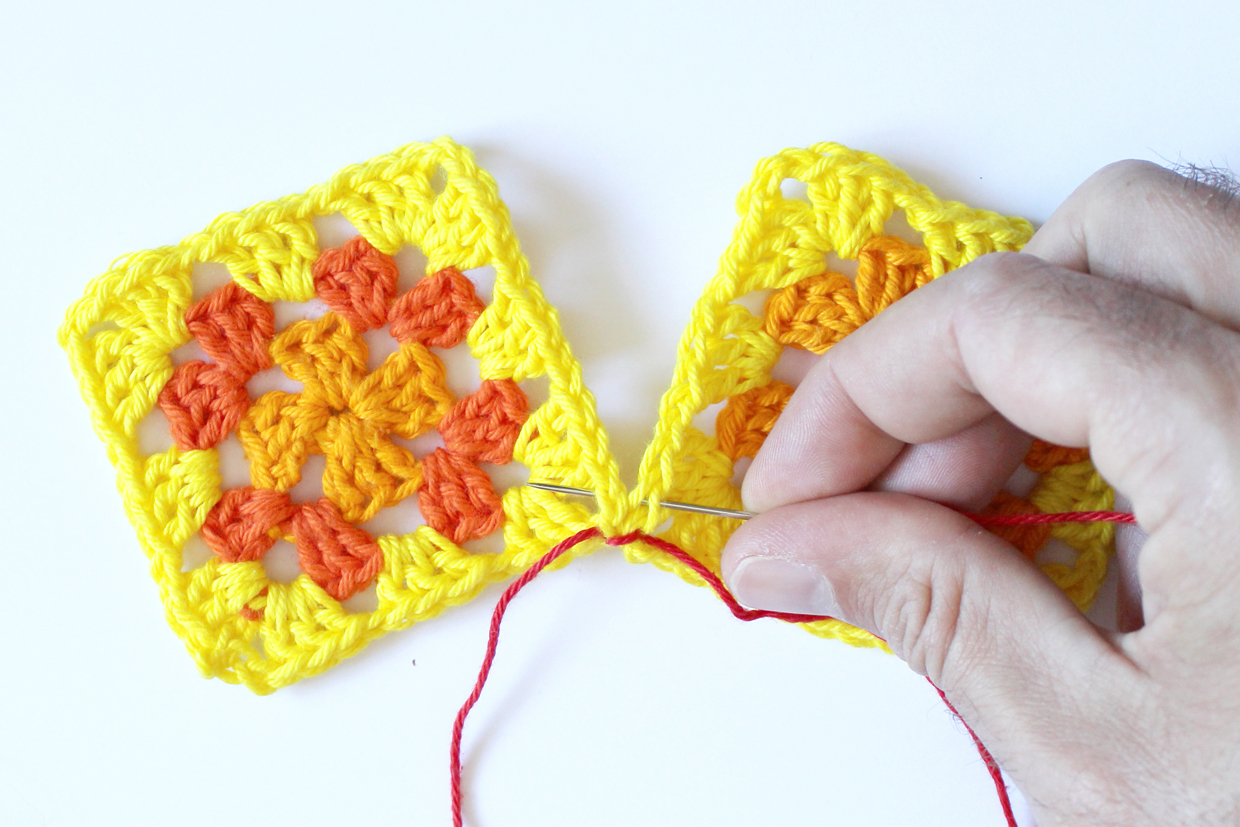
Step 2
Then just repeat, working into the next stitch on the right hand piece and then then corresponding stitch on the left hand piece, until you have joined your sides. You can finish off with the same method as we used to join the yarn in the first place, and then just weave in your ends.
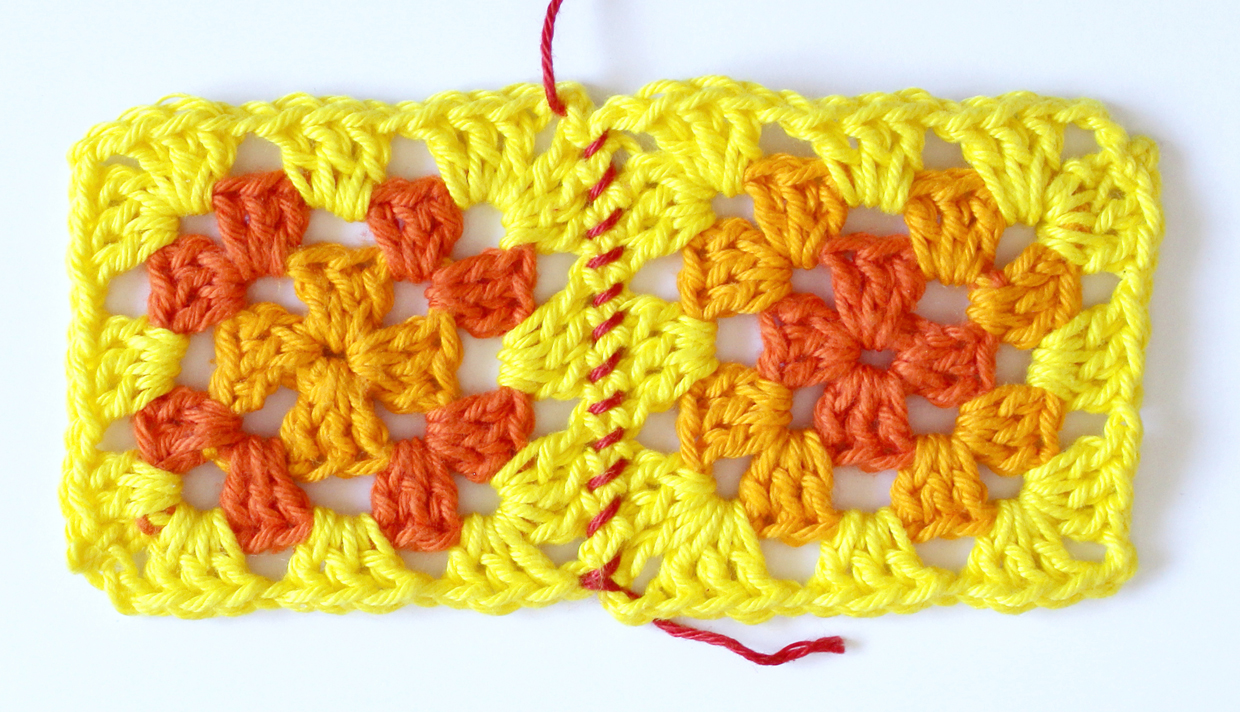
As you can see, whip stitch is a super-quick way of joining crochet shapes and is pretty simple when it comes to counting your stitches.
However, it’s not the neatest method, and once you’ve finished, the join will be pretty solid – which is good for projects that you want to be sturdy and solid, but it’s not great for things like garments that might need a little bit of stretch.
Needle weave join
Step 1
If you’re looking for a slightly neater needle crochet join, and one that has a bit more give to it (important for if you’re making a garment that will need to stretch a bit), then one of the best crochet joining techniques is to make a needle weave join.
Start by joining your yarn to both pieces as in the method above. Then start by threading through the next stitch on the right hand piece and the corresponding stitch on the left hand piece, just the same as you would with a whip stitch.
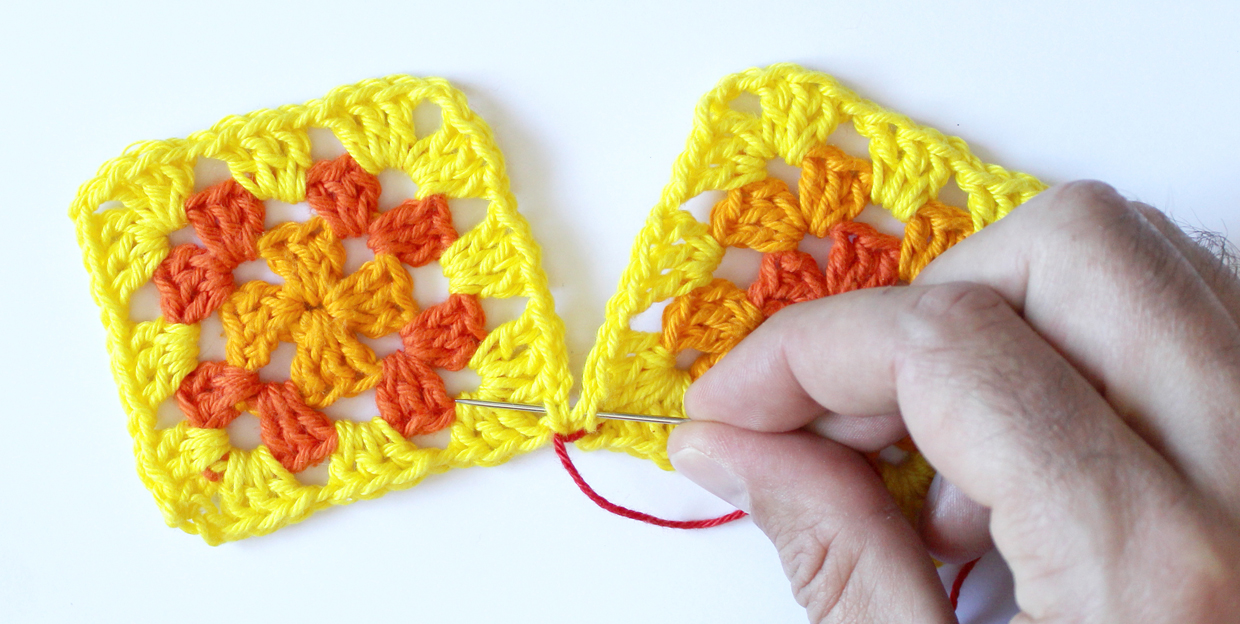
Step 2
Now thread your needle into the next stitch along on the left hand piece, taking the needle from front to back. We’ll then thread our needle back into the same place as the previous stitch on the right hand piece (needle going back to front)
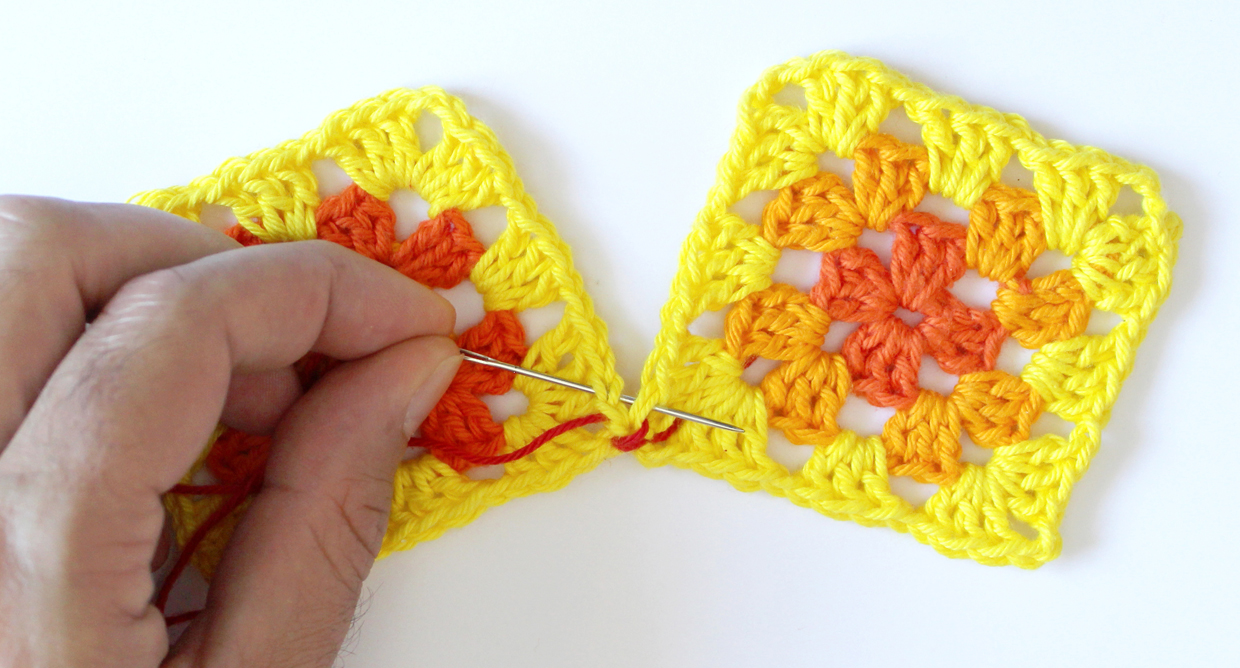
Step 3
Now, insert your needle (front to back) through the next stitch along on the right hand piece, and back into the same place as the previous stitch on the left hand piece (back to front).
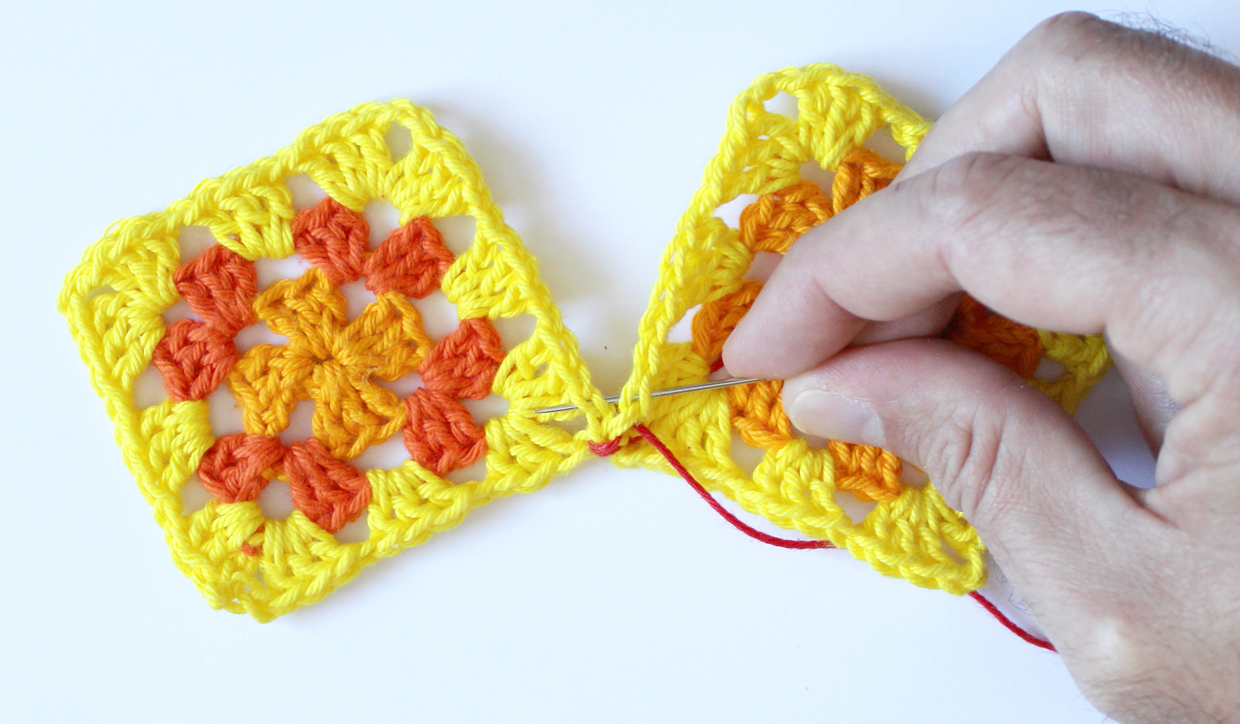
Step 4
Continue along repeating steps 2 and 3. This can get a bit confusing at times, but you can simplify it to thinking of it as:
Same place as last time on first shape, next stitch on first shape, same place as last time of second shape, go into next stitch on second shape.
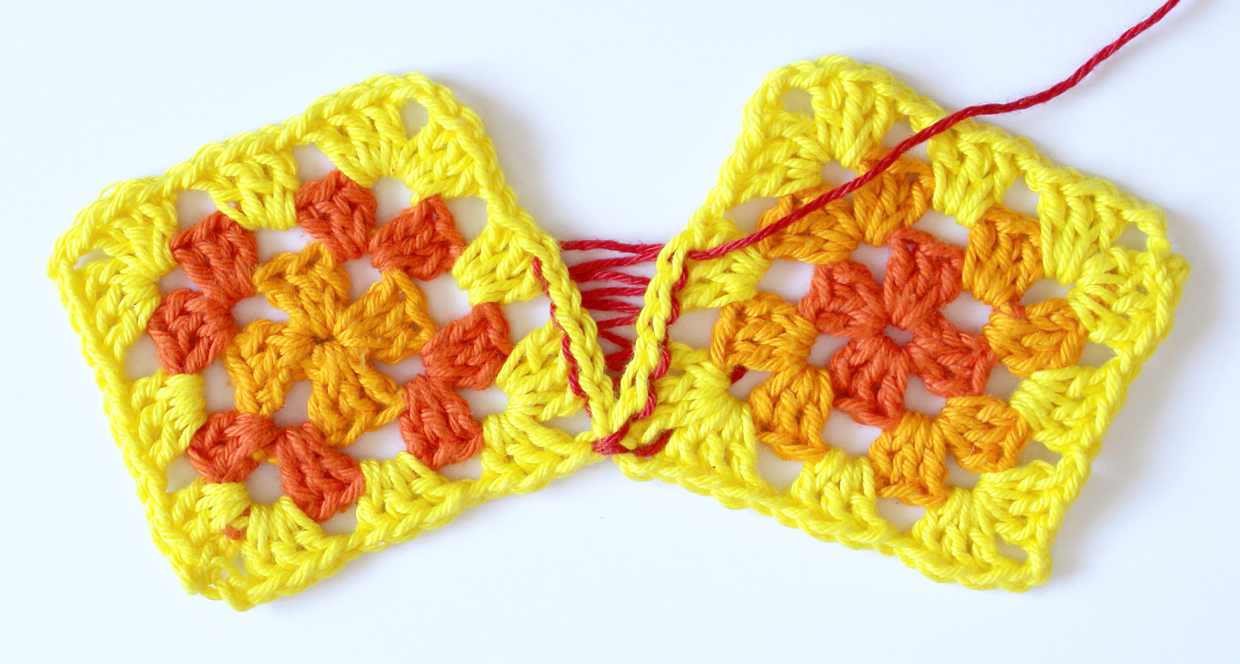
If you’re struggling to understand the sequence, this diagram might help.
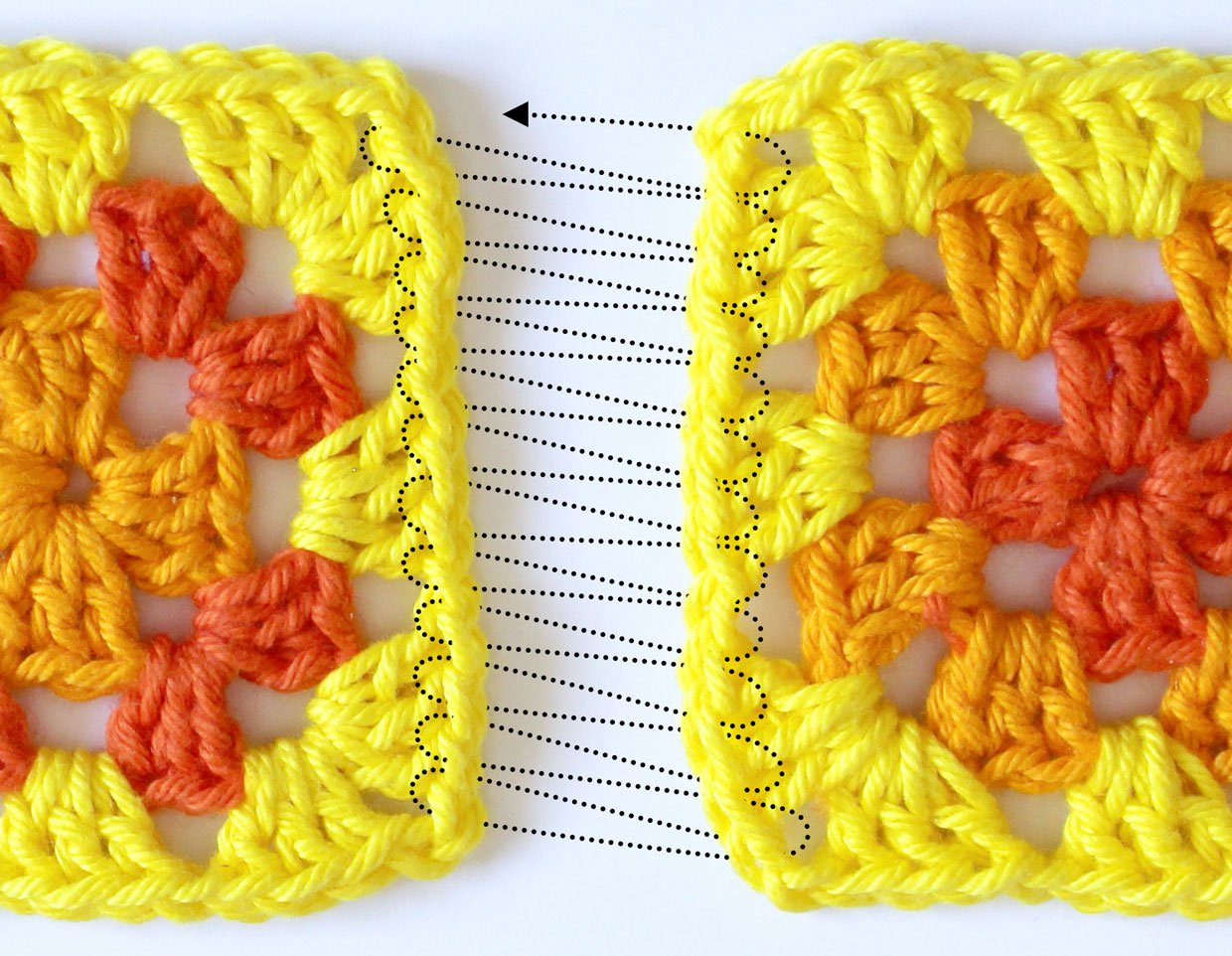
Step 5
As you work along give your thread a pull from time to time, but not too tightly, remember that you want your crochet to sit naturally and have a bit of give to it. Once you have worked into both of your last stitches you can tie off your yarn and weave in your ends.
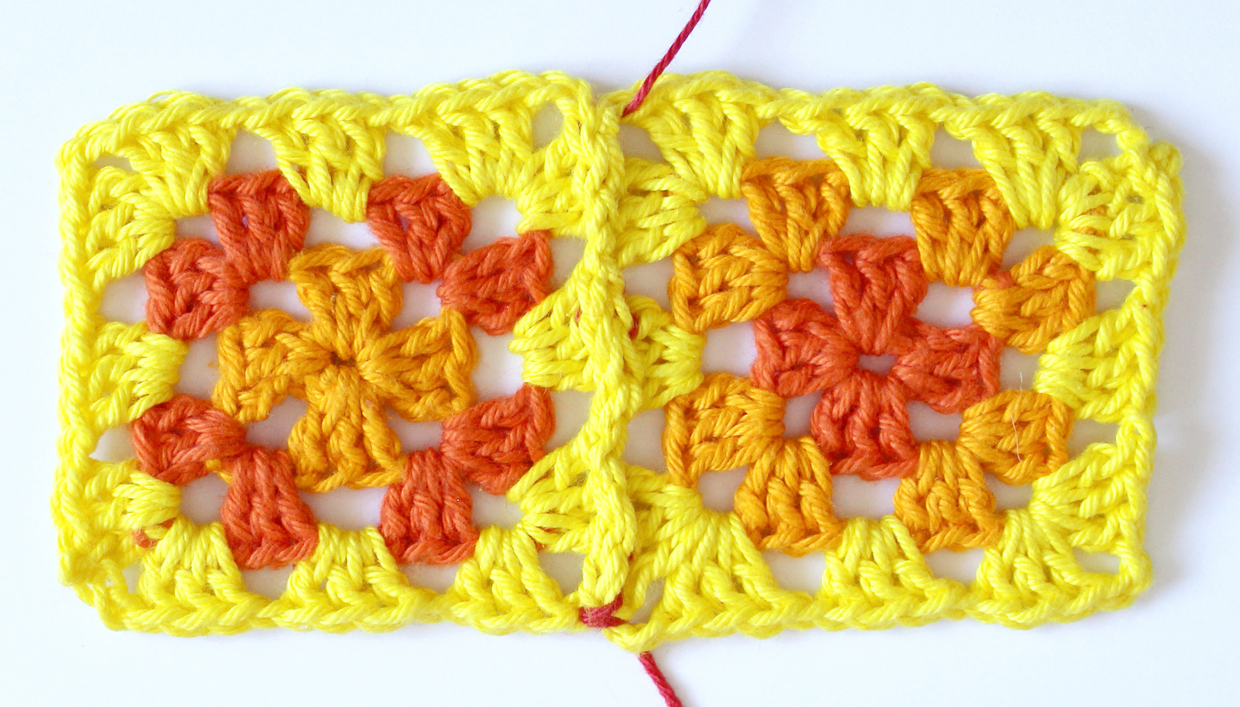
As you can see above, by weaving your shapes together you get a much less obvious join, which should hopefully be a bit more flexible than a whip stitch.
One downside of this crochet joining technique is that it can ruffle up your edges a little bit, meaning that if you’re making something to precise measurements it may take off some of your width.
Slip Stitch Crochet Join
Step 1
If the idea of sewing all your crochet pieces together has you yawning with boredom already, fear not, you can always join your shapes with your crochet hook!
It's significantly quicker for us hooksters, and again there's a couple of different crochet joining techniques that you can use.
A bit like the whip-stitch method, slip stitch joins are a super-quick crochet join that is easy to do.
Start by making a slip knot to attach the yarn to your hook. Insert your hook through the first stitch on your right crochet piece (under both loops, going front to back) and through the corresponding stitch on your left crochet piece (under both loops, going back to front). Then just slip stitch as normal - yarn round hook, pull through work and loop on hook.
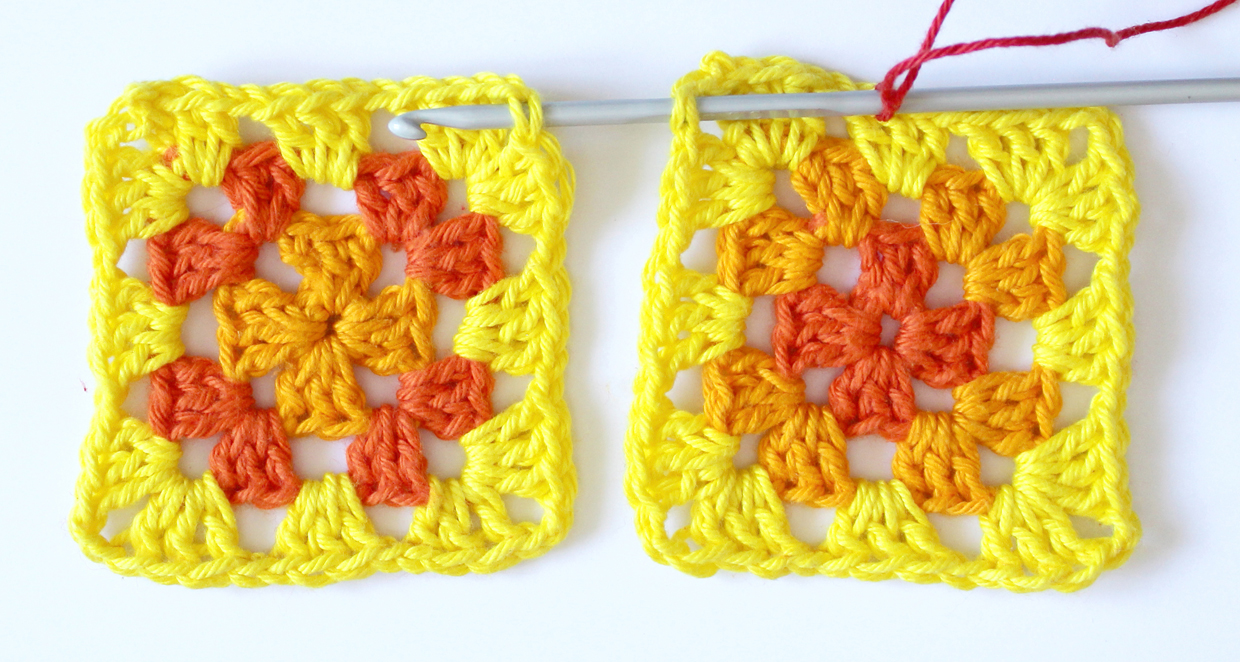
Step 2
Now just continue along, slip stitching the next stitches of both sides together. You may find it easy to almost 'sandwich' the pieces together so you can place your hook through both pieces in one go. Once you reach the end you can fasten off as normal
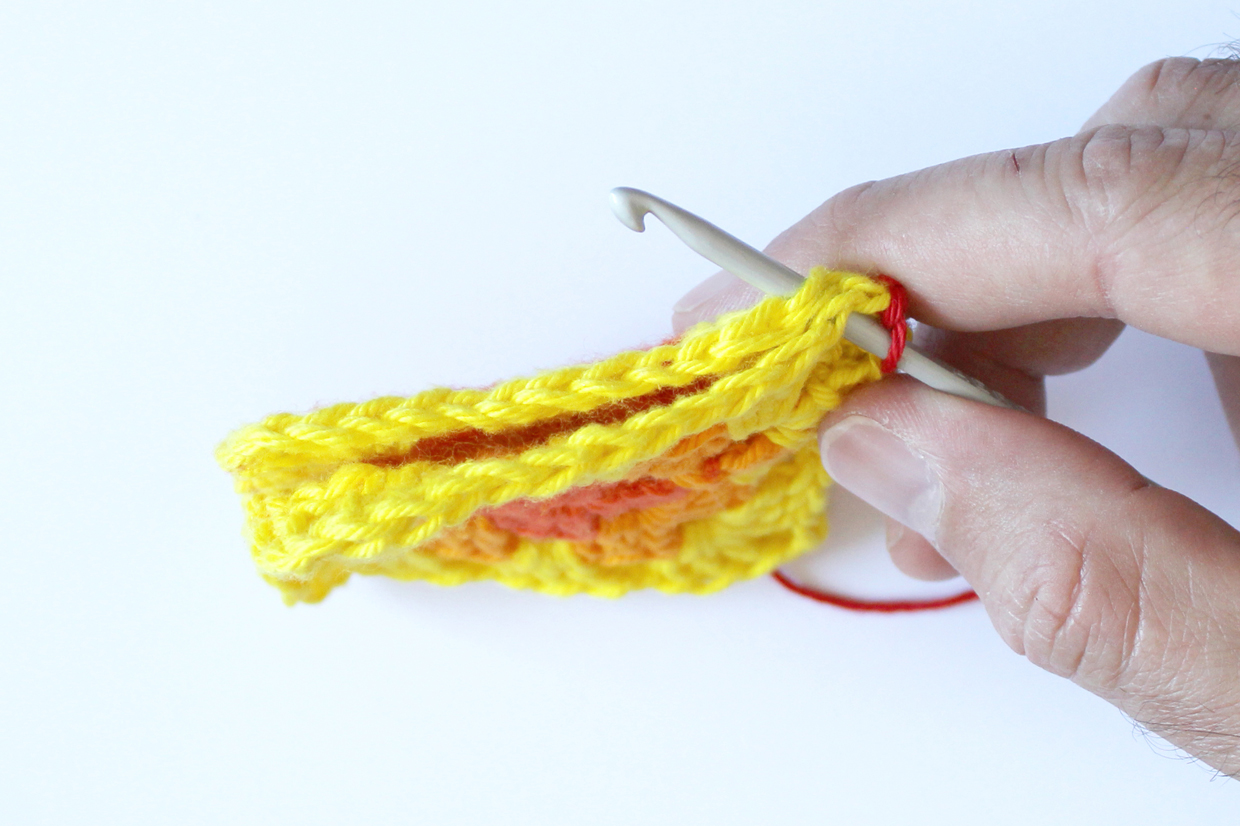
And that's how you do a quick slip stitch crochet join. As we mentioned earlier, normally you would do your crochet join with the wrong side facing.
Slip stitch crochet joins tend to raise the fabric a bit where the crochet join is, and slope to one side when the join is facing you, like in the image below.
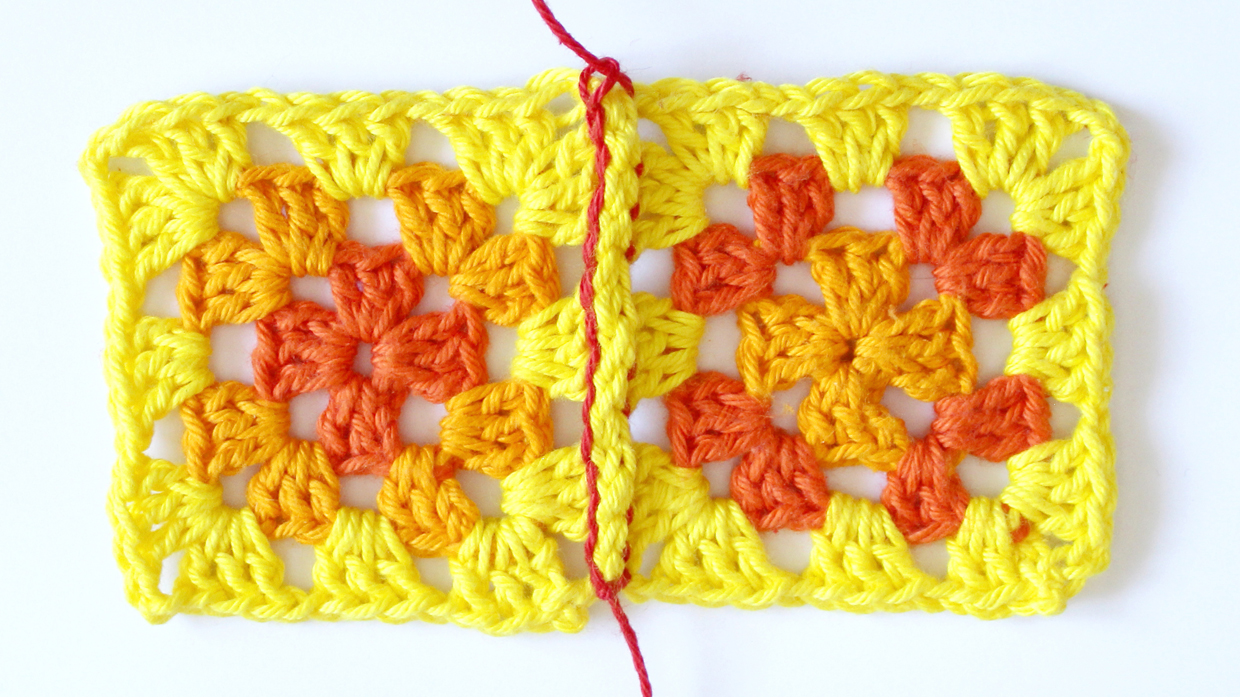
However the back of the crochet join does look quite neat, with little horizontal lines like in the image below.
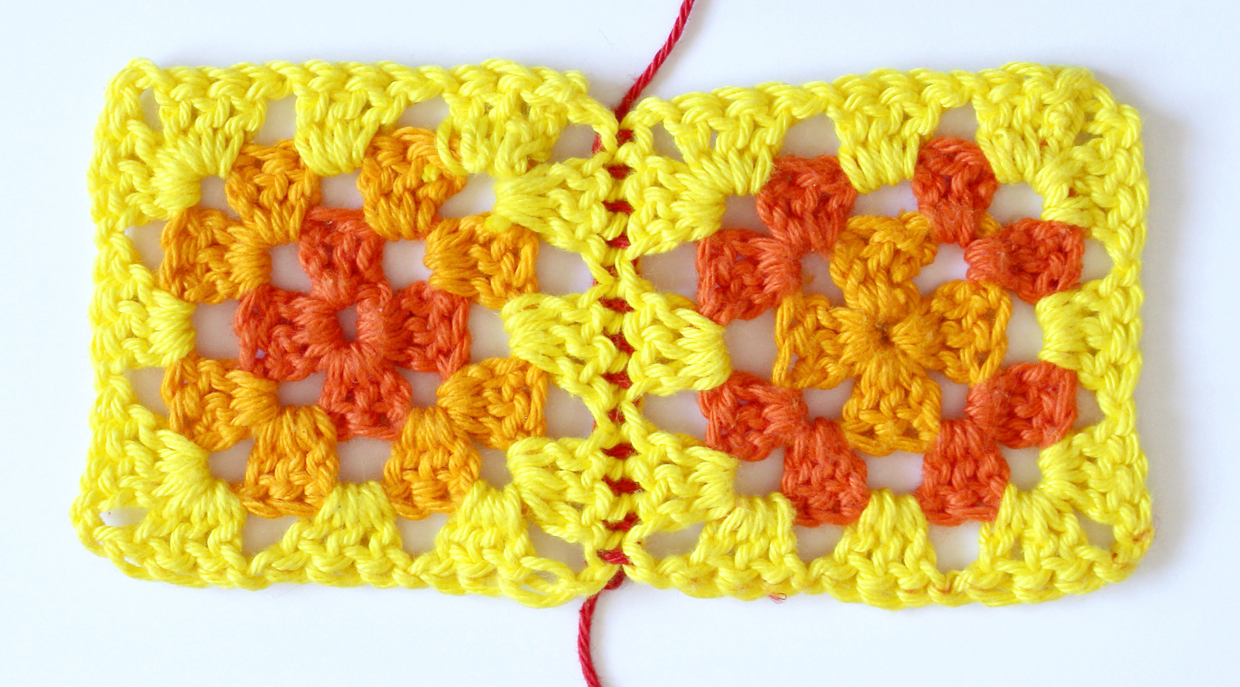
Double crochet join
Step 1
Double crochet joins are not only a nice way of joining shapes together but also add a nice decorative quality.
As they're more raised than our previous joins, they can create a nice waffle-like texture - it's our favourite of the crochet joining techniques for how to join granny squares together! When doing a dc crochet join, you would always do your join on the right side of your work.
The best way to start a dc join is with what is called a standing stitch - basically you just go straight in and start with a dc, no need to slip stitch or ch1!
So make a slipknot and put the yarn on your hook, insert your hook through the first stitch on your right crochet piece (under both loops, going front to back) and through the corresponding stitch on your left crochet piece (under both loops, going back to front), yarn over hook, pull through the work, yarn over, pull through both loops on your hook.
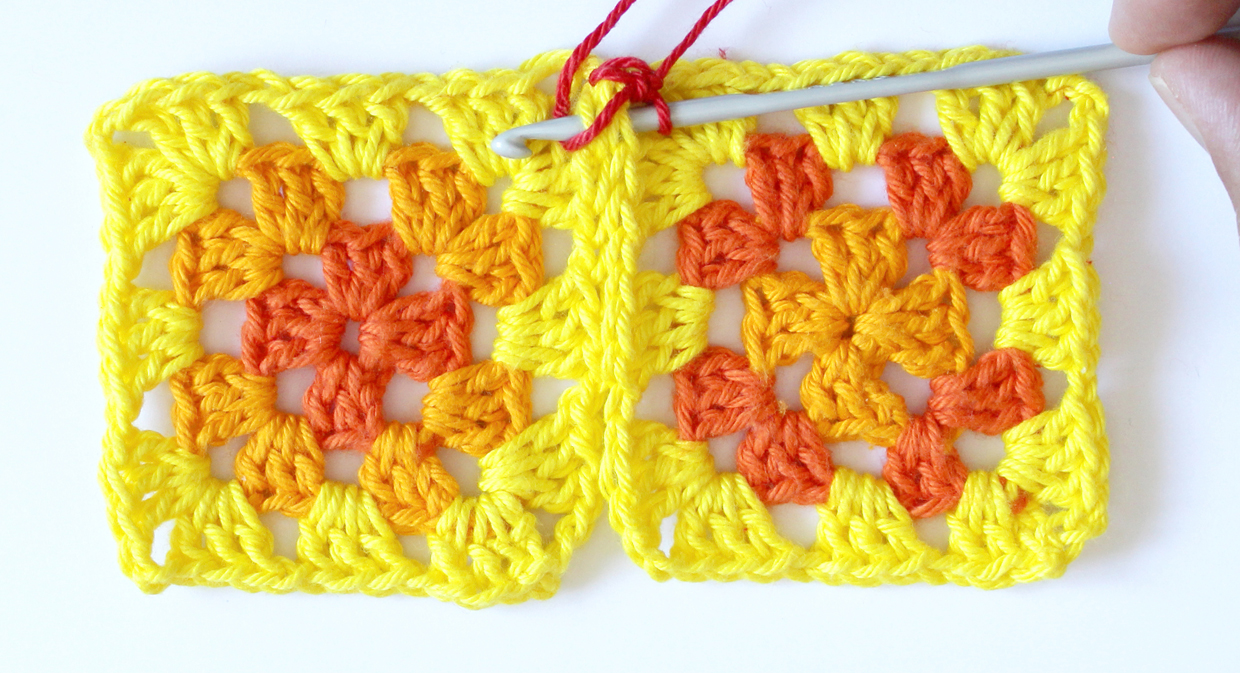
Step 2
Continue dc stitching along until you've competed your crochet join. Dc joins will ever so slightly lean to one side, so it's important to remember to always do your joins going in the same direction for a neat final project (i.e. top to bottom or bottom to top).
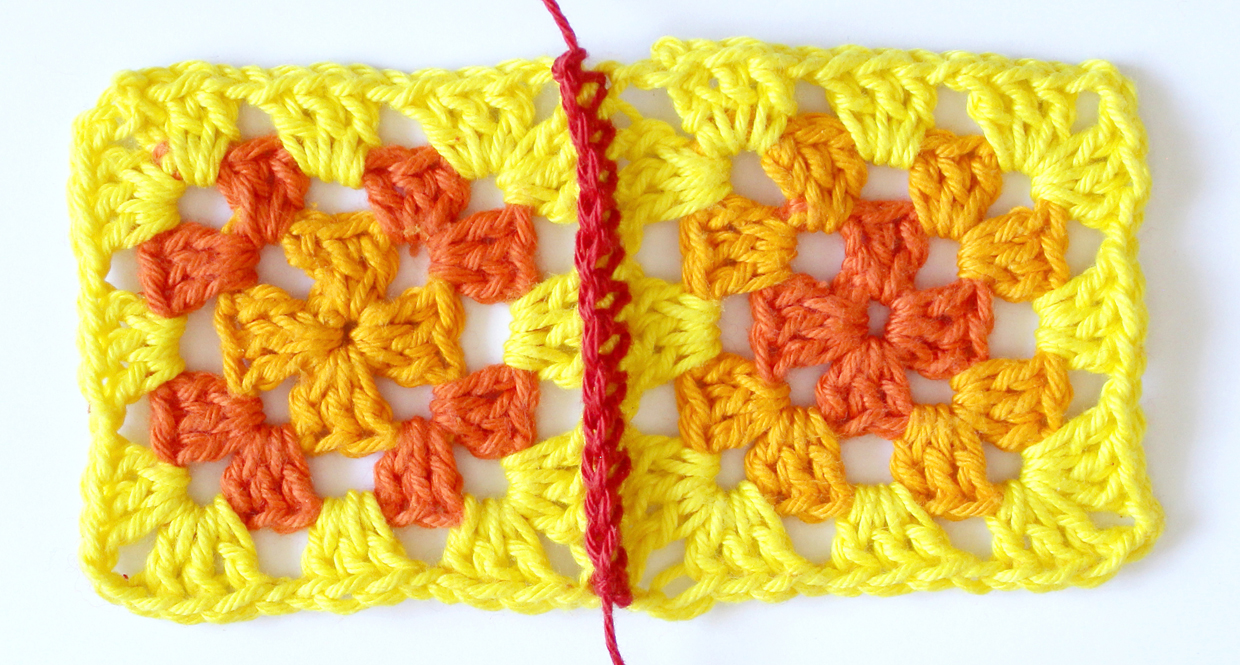
Again like the slip stitch join method the reverse of your crochet join will look like little horizontal stitches.
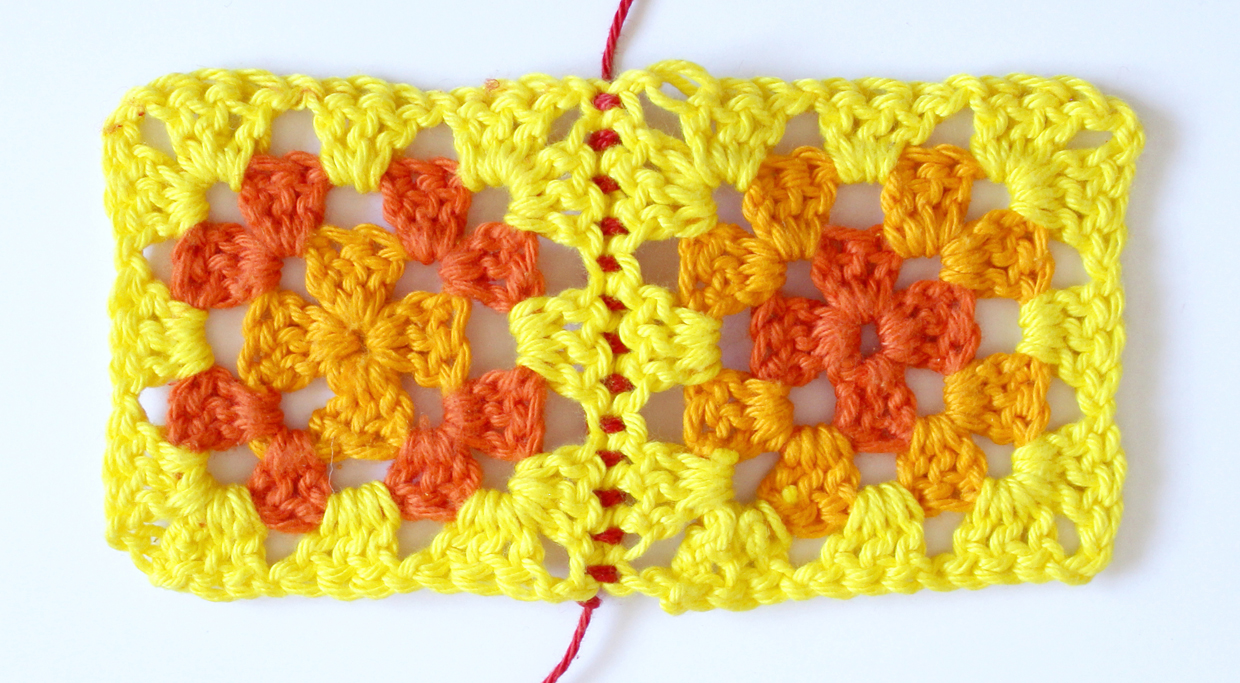
One of the reasons we love double crochet joins is that they're easy to do and can be used to join a whole project very quickly – they're one of our favourite ways of how to join granny squares if you're making a blanket!
You start off joining granny squares together into vertical strips. Then when it comes to the horizontal crochet join, you would just work across up to your first vertical crochet join, then you can simply ch1 which will take you over the join, then continue your horizontal join on the next square along.
Zipper join method
Step 1
Although all of the crochet joining techniques above are fantastic for quick and easy joins, perhaps you fancy a super-neat join that works seamlessly with your crochet - well the zipper join method is perfect for this!
It's essentially a slip stitch join done slightly differently, and creates a crochet join that is perfectly flat and doesn't ruffle up your crochet at all. It can seem a bit tricky to start off with, but once you get the hang of it it's sure to become your favourite way for how to join granny squares together.
Insert your hook (going front to back) in the BACK LOOP ONLY of the first stitch on your left hand piece of crochet
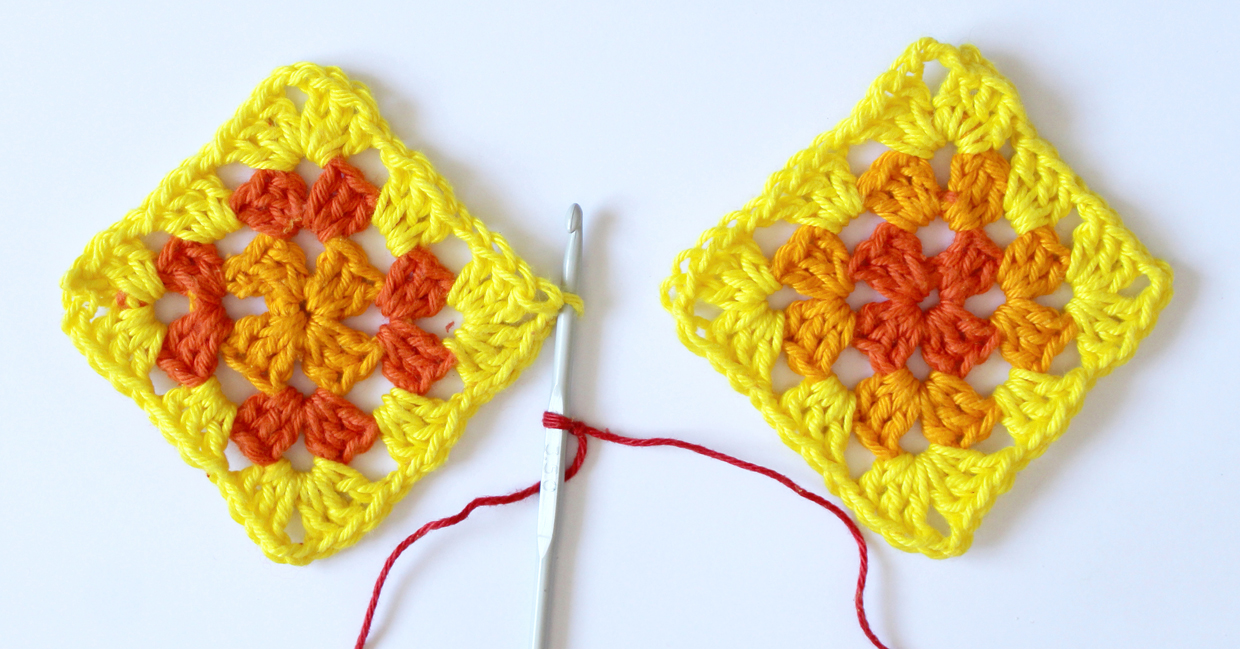
Step 2
Now insert your hook (again going front to back, you will need to twist your hook a bit to do this) in the BACK LOOP ONLY of the first stitch on your right hand piece of crochet
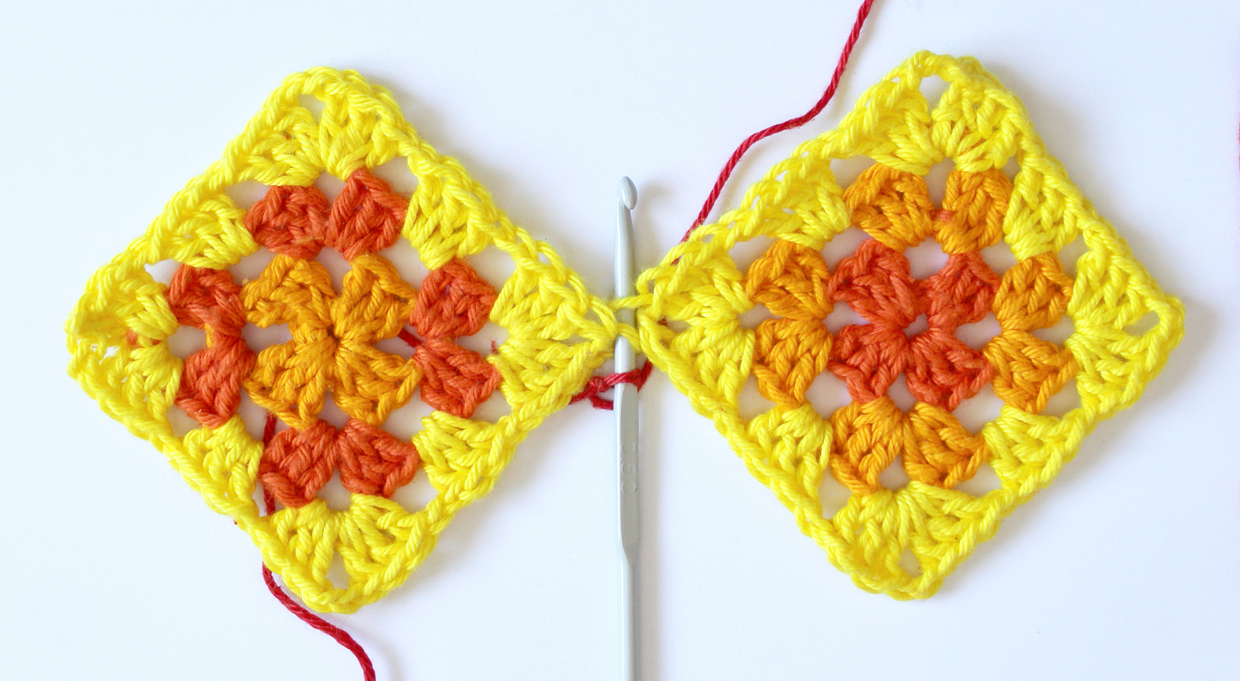
Step 3
Now yarn over hook. With this method it is important that when doing your yarn over that the yarn is coming from the back of the join.
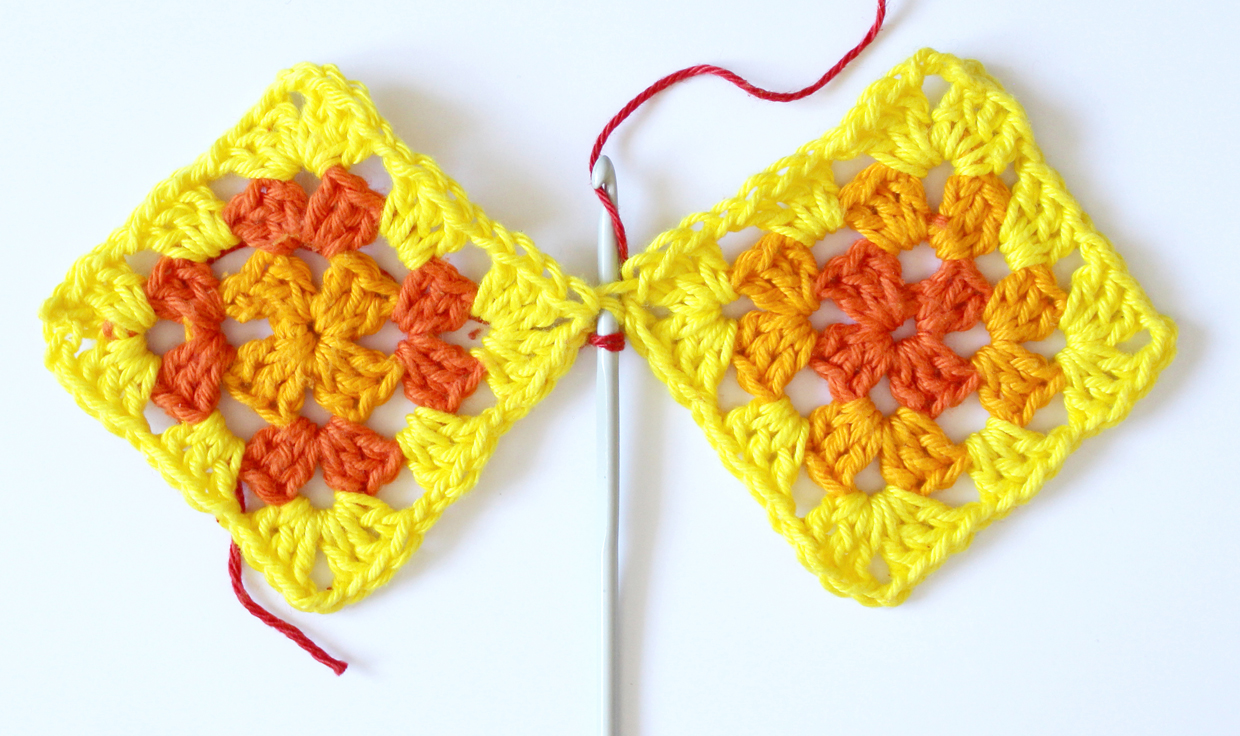
Step 4
Then pull through the work and the loop on your hook (just like a normal slip stitch). That's essentially all there is to it, but we'll carry on with the next join.
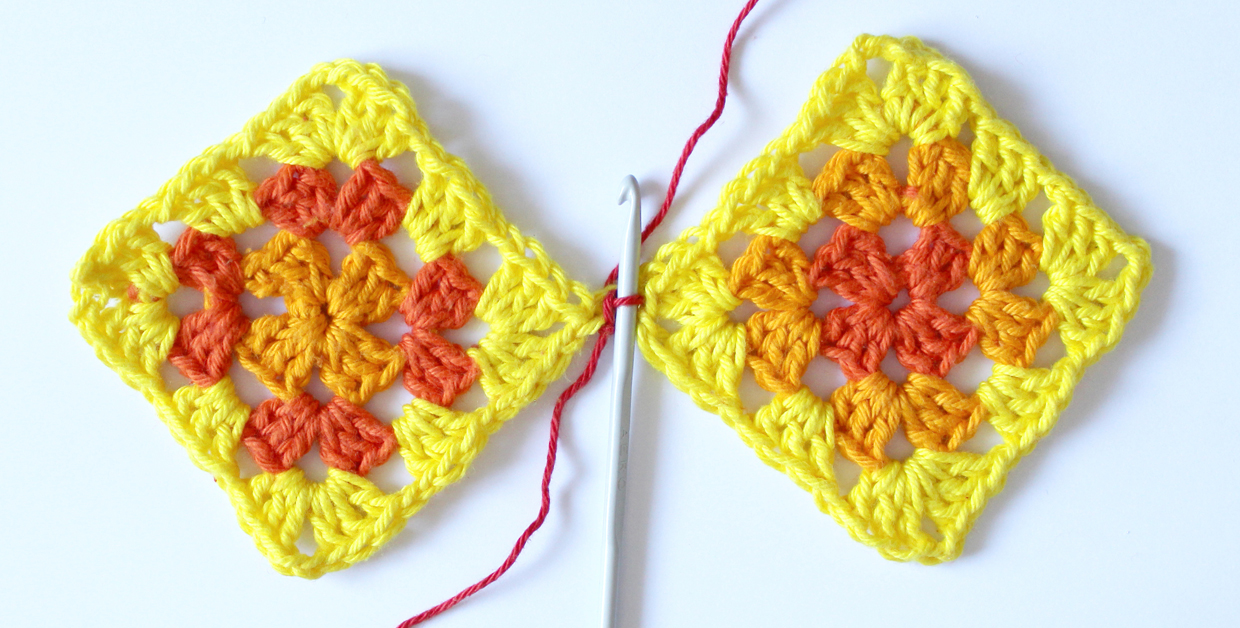
Step 5
Insert your hook (going front to back) in the BACK LOOP ONLY of the next stitch on your left hand piece of crochet
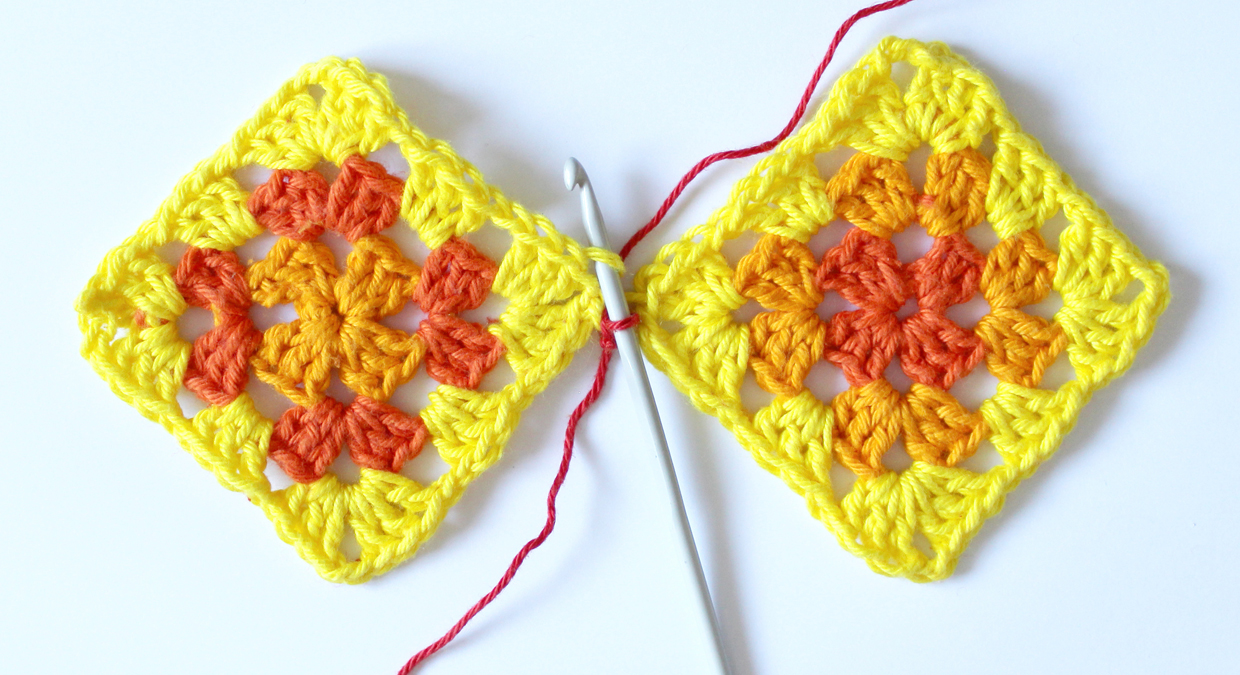
Step 6
Now twist your hook to the front and (again going front to back) insert your hook in the BACK LOOP ONLY of the next stitch on your right hand piece of crochet.
Make sure that your yarn is still at the BACK of your work - it's quite easy to accidentally catch the yarn and bring it to the front, so you need to pay attention to this and may need to reposition the yarn as you do this step.
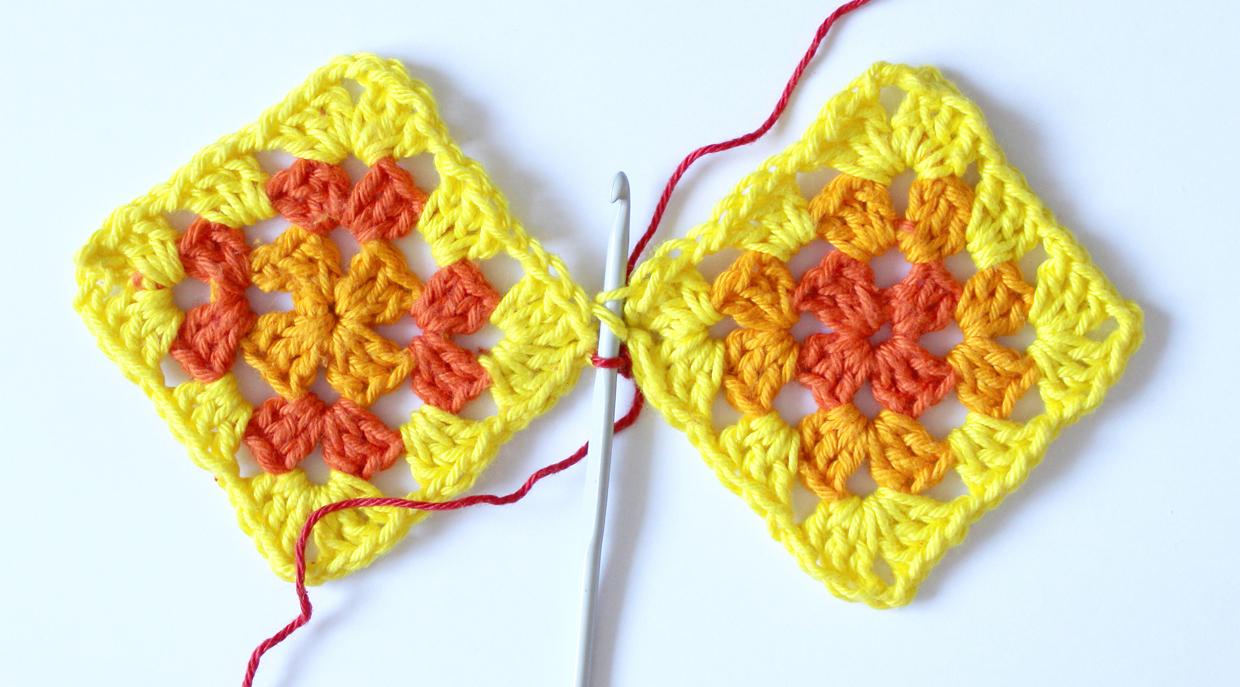
Step 7
Then just yarn round hook, pull through the work and through the loop on your hook like a normal slip stitch.
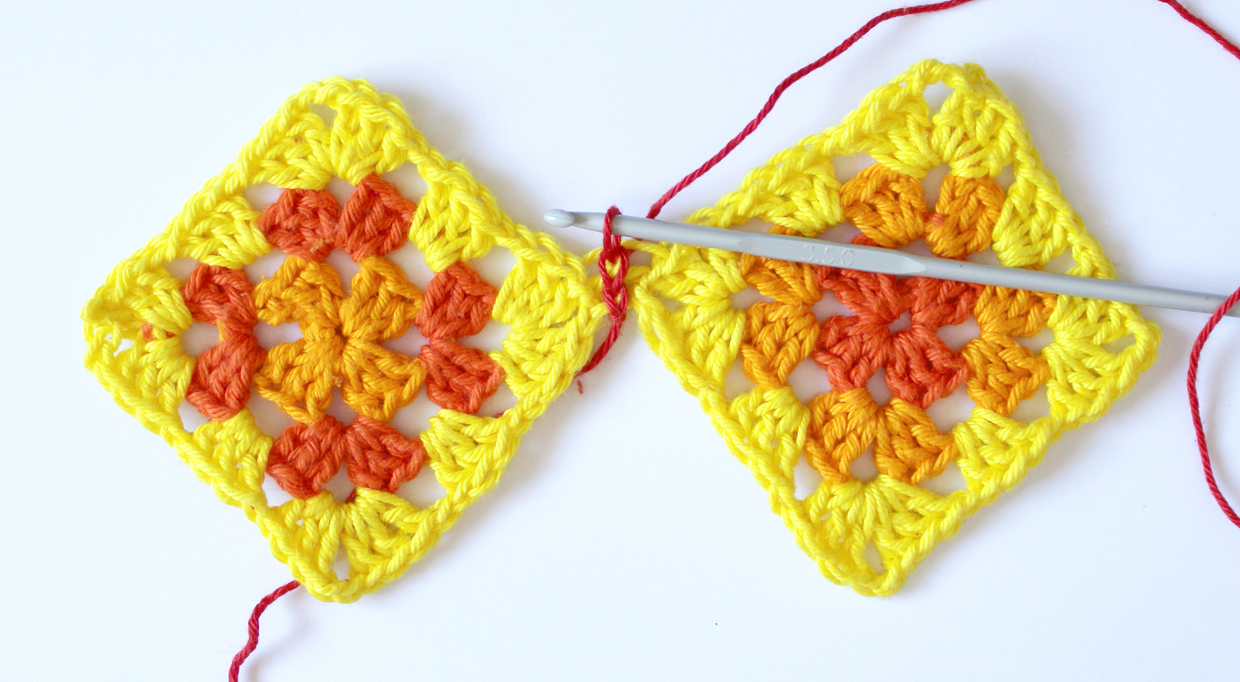
Step 8
Continue along to your last stitch and then fasten off. Once complete you can see why this join is called a zipper - because it looks like a nice little zip.
This join will lie almost completely flat with your crochet pieces, and as it's joined in the back loops only your crochet shapes will still have a nice defined edge and won't ruffle up at all.
Again like the dc join, when you come to horizontally joining shapes over vertical joins, you can simply ch1 to skip over the existing horizontal join.
